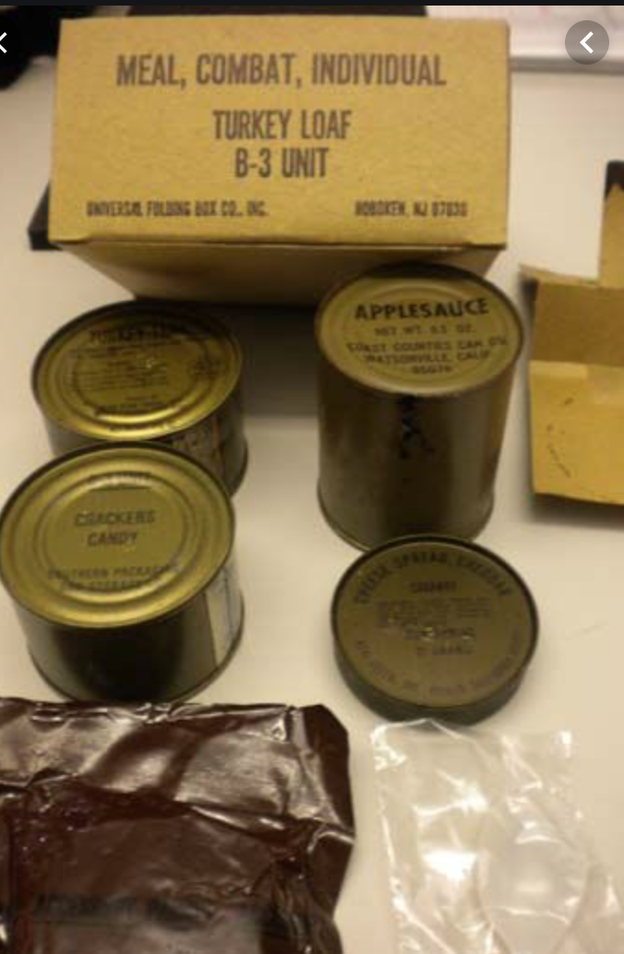|
David Mitchell
It would seem that this is a week when food is on our minds.
This "food story" comes to mind.
14 - JIM LOVES HIS TUNA FISH
One of my good buddies, and my eventual platoon leader was a guy named Jim. He was a first Lieutenant on arrival, but by this time he was a Captain, and I often flew his “wing”. We were a good team. He happened to be a very tiny, skinny guy, but with a huge appetite. The lunches we ate in the field (those days on which we were flying and away from our “Mess Hall”) were the legendary “C-rations”, most of which weren’t very good. Some of us went to great lengths to acquire other food sources for our flying days. I personally had acquired two cases of individual cans of VanCamp’s Beenee Weenee’s that I lucked into on my one and only visit to the tiny PX at Soc Trang - a smaller, quieter base where I went to take one of my semi-annual “check rides” (a sort of pilot proficiency exam).
Jim had acquired a large stash of his favorite - canned tuna - probably in a care package from home. He would take not just one, but two or three cans of tuna in his Loach on days he was flying. And we all had our trusty “P-38” folding can openers on our dog tag chains. We Scout pilots stuffed our “C-rats”, or whatever meal we had, in a space down beyond our anti-torque pedals and at the bottom of the cockpit “bubble” in the front of the ship. You could actually see it through the plexiglass from the outside front of the cockpit better than from the inside.
It was a day we were working way south, out of Vi Thanh (“vee taun”) - a place where we often ran into trouble. I was flying Jim’s “wing”, and we were slowly weaving our way along a small canal with the typical thin wood line along side of it, so we were up at about 25 feet. We came to another canal and tree line intersecting this canal, and Jim made a hard banking right turn and I followed him along the new canal line. As soon as I made the turn, I had this immediate sense of something or someone beneath us and called out to Jim, “One six, I think we’ve got some people down here.” Not that I could actually see anyone - just a sense of their presence. (A common feeling after we became more experienced). Maybe it was the sight of a few fresh cut "Nipa Palm” leaves (camouflage) - I don’t recall exactly.
I had barely finished speaking when Jim calls out “Receiving Fire, Receiving Fire”! He abruptly banked his ship away to his right and I laid down a quick burst of cover fire underneath him with my mini gun. Then I pulled away hard in the opposite direction.
Then followed a bit of radio silence, and I could not see Jim’s ship anywhere. I flew a quick, tight circle to get a good look around in all directions and still could not see him. I thought he’d been shot down, but where? I called out for him, “One-six, One-six - this is One-three. Where are you One-six?” No response.
Then our AMC, Major Rittenhouse called out, “Oooone-Six,,,, Oooone-Six, this is Six, Where are you One-Six?” No response, another pause, and then again, “Comanche One-Six, this is Comanche Six - C’mon back buddy.” Another long silence.
Finally, I caught sight of Jim’s ship. He was several hundred yards out and circling up at about fifty feet of altitude. And he finally responded to the Major’s call.
“Comanche Six, this is One-Six. We took a couple hits in our bubble and have some visibility problems,” Another pause - “We have tuna fish splattered all over the inside of the cockpit and a clump of it on my visor”. He had taken a direct hit right through several of his cans of Tuna and they had splattered everywhere in his cockpit.
For about a second, Major Rittenhouse had his microphone open, and you could hear just a moment of his hysterical laughter over the air. And I started to laugh out loud myself. We all headed back to Vi Thanh to switch teams and let Jim assess the damage and clean up his cockpit. There were several large clumps of tuna on the inside of his plexiglass bubble, along with some larger spots of smeared fish oil. With a bit of cleanup, his ship was still flyable. The bubble would later be replaced back home by our maintenance guys.
We teased Jim about it for weeks afterwards. I seem to recall someone even suggesting he might be safer if he switch to canned salmon.
The dreaded "C-Rations"

And the legendary P-38 (can opener). One of the mankind's greatest inventions!
|